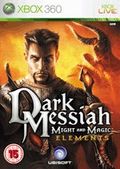You can trust VideoGamer. Our team of gaming experts spend hours testing and reviewing the latest games, to ensure you're reading the most comprehensive guide possible. Rest assured, all imagery and advice is unique and original. Check out how we test and review games here
Developed by Arkane studios of Arx Fatalis fame, Dark Messiah of Might & Magic wasn’t a game topping our radar a few months back. Yet, after an afternoon in a cramped underground crypt once used by Henry VIII for celebrations, we’re now a little more excited about Ubisoft’s upcoming first-person fantasy-based action title.
Hands-on sessions aren’t always atmospheric, nor are they always fun, as at certain stages in a game’s development, features can be missing or the product is just nowhere near finished quality. Luckily for us, the Kuju-developed multiplayer component we were invited to play was an almost final build, with only minimal balancing and optimisation to be performed before the release later this year. For those denying yourself the rest of the feature and wanting the opinion now, it’s bloody good fun! But what makes it so great?
Valve’s Source engine has already powered some great looking games, and Dark Messiah certainly isn’t going to let the side down. From the moment you take your first step in any of the maps, you’ll be suitably impressed by some fantastically drawn indoor and outdoor environments. High resolution textures can be seen everywhere, in the detailed sand, on the surface of massive boulders, and on the walls of buildings, all of which never fail to impress. Multiplayer components often come across a little bland when compared to the detailed single-player games they ship with, but Kuju have worked tirelessly to create the same beautiful surroundings as found in the campaign mode.
‘But it’s Multiplayer. There are no scripted events or any such window dressing. How can it look so good?’ I hear you say. Up to 32 players can play at any one time during multiplayer matches, all with the same level of graphical detail as seen in the single-player game, and yet still we’re treated to HDR lighting effects and some wonderful self shadowing techniques. It’s not often this writer praises Kuju for their efforts, but they’ve certainly outdone themselves this time.
In Crusade mode, the core team-based multiplayer game type, playing as either the Humans or the Undead, you’ll have five maps to campaign across. This sounds quite low, but these aren’t small maps by any stretch of the imagination, with five spawn points spread out along the route to the opposition’s base. What’s more, numerous character classes add depth to the online experience.
As you progress, the skills you earn during each round of gameplay can be carried over to the next. Not the most original of ideas, but certainly one that works well, enticing you to play just that little bit longer, and with over 50 skills to perfect, you’re sure to play for hours before reaching the upper echelons of combat experience. Standard skills include invisibility for the Assassin and fast running for the Warrior, but newly earned skills give you an advantage over the other players.
You’ll have five character classes available to choose from (Mage, Priestess, Warrior, Archer and Assassin), with each having its pros and cons. Taking the Warrior as an example, his large amount of armour means you’re almost immune to an archer’s bow, but an assassin could be very effective with close range dagger attacks. Making Dark Messiah’s multiplayer mode well balanced is something Kuju have strived for from the beginning, and they seem to have succeeded.
Another example of good balancing was demonstrated by pitting one Warrior against another. Quick attacks just bounce off each player, with only strong attacks making any headway on the other player’s health. However, strong attacks take longer to perform, leaving you vulnerable. When you’re duelling with another Warrior, tactical swordplay comes into its element, with a well-balanced tug of war taking place until someone makes a mistake. It’s little touches like this that make Dark Messiah all the more enjoyable.
With only a few months of development left, unless something drastic goes wrong, it should become a firm favourite for those that want a more tactical title, rather than blast their way through the next Quake rip-off. One way to describe the multiplayer element would be the sheer delight experienced when confronted with an oncoming Warrior in the shape of Ubisoft’s Community manager. The adrenaline rush kicked in just in time for me to draw my bow back and shoot him square in the face with an arrow, killing him instantly.
Aside from Crusade, other modes on offer are the usual Deathmatch, Team Deathmatch, and Capture the Flag, with Arkane confirming that there’s more to be announced once the game launches. Hopefully these new modes will offer the same kind of depth as seen in the Crusade mode, but what’s included from the off seems more than good enough. Often, it’s not new elements, but the basics done well that make a successful multiplayer experience. The class system in Dark Messiah seems perfectly balanced, and should this prove to be the case after prolonged play, Ubisoft will have a bona fide hit on its hands – great single-player campaign or not.
Keep your eyes peeled later this week for an exclusive interview with Arkane Studio’s Romain De Waubert De Genlis, on working with Kuju on the multiplayer aspect, and just how well the single-player game is shaping up.
Dark Messiah of Might and Magic: Elements
- Platform(s): PC, PlayStation 3, Xbox, Xbox 360
- Genre(s): Action






